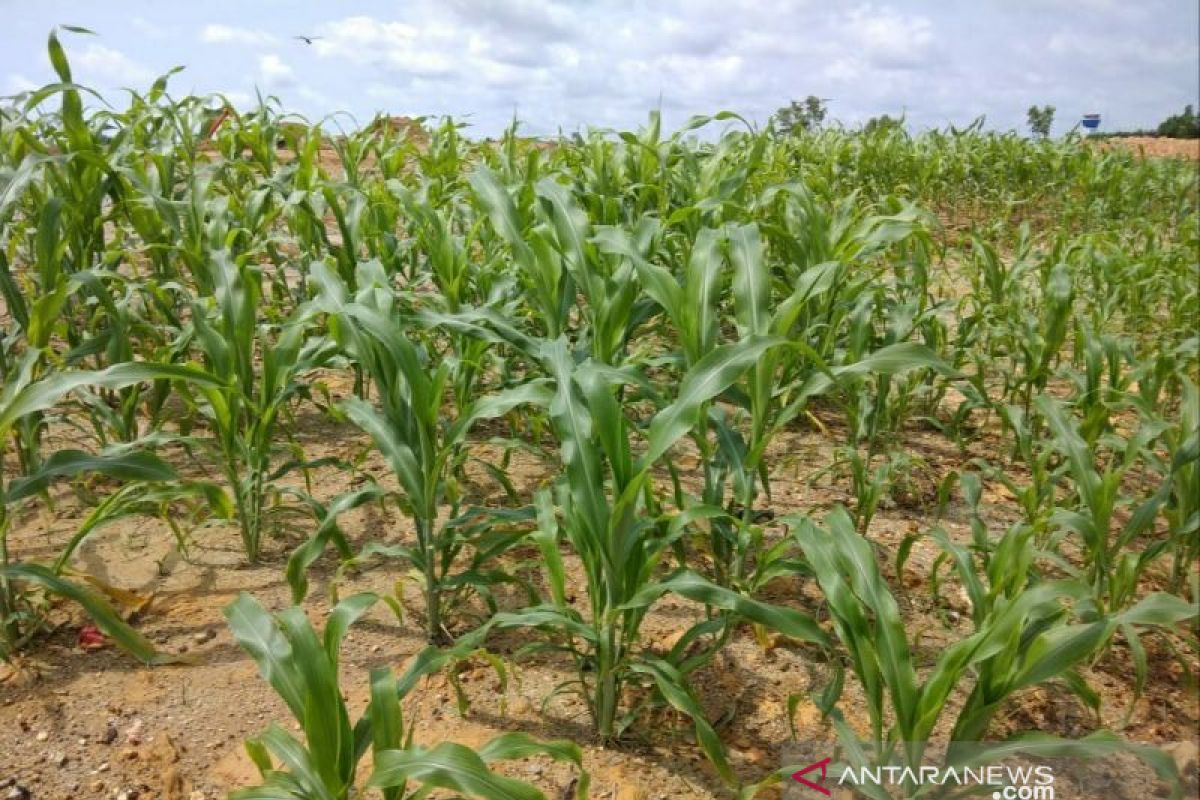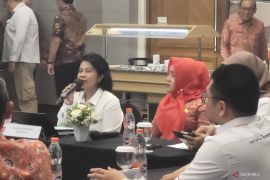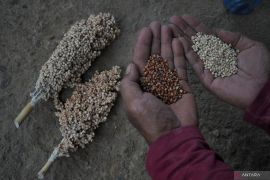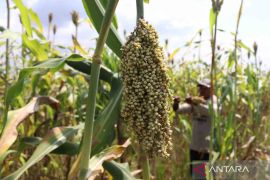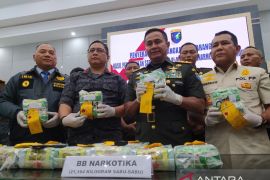The Cereal Crops Research Institute (Balitsereal) of the Agricultural Research and Development Agency quoted as saying from various sources that the sorghum plant is native to Ethiopia, East Africa. This plant made its way to Indonesia, as it was brought by the Dutch colonial government in 1925. The development of this plant in Indonesia was only seen in 1940.
Sorghum plants are characterized by green trunks in the form of tubes with knuckles, and its height can reach up to four to five meters. The leaves are long and tapered at the ends akin to corn plants. Sorghum falls in the same family as rice, wheat, adlay, and corn.
Sorghum, with its high adaptability and resistance to drought, is found across the world, including Indonesia.
The US, Argentina, China, India, Nigeria, some East African countries, Yemen, and Australia are currently producing sorghum.
Meanwhile, in Indonesia, the Agriculture Ministry stated through its official website that sorghum was widely cultivated in 1970. Their cultivation sites include East Java, South Sulawesi, Southeast Sulawesi, West Nusa Tenggara, and East Nusa Tenggara.
Sorghum can grow and develop well at 20-30 degrees Celsius, low humidity, and rainfall of 400-600 millimeters. This plant can grow in various types of soil in Indonesia.
Given its flexibility, this multipurpose plant garners the interest of farmers in West Kalimantan.
Sorghum in West Kalimantan
So far, the West Kalimantan Food Crops and Horticulture Agency has only recorded three districts -- Mempawah, Bengkayang, and Sanggau -- where farmers have cultivated sorghum.
The land for cultivation of this plant varies in size. Some have just conducted trials on an area of 0.25 hectares, some have conducted planting on up to five hectares of land, and some have planted on a land spanning seven hectares.
One of the locations for sorghum cultivation is at the Indonesia-Malaysia border, precisely Nekan Village, Entikong District, Sanggau District.
This plant cultivation business is initiated by a group of farmers, who are members of the Indonesian Border Consumer Cooperative, on an area of 0.25 hectares. Farmers form two demonstration plots measuring 25 meters x 25 meters. Currently, only one demonstration plot has been harvested, which yielded 500 kilograms of sorghum.
For the second harvest, at 50 days, the plot is expected to produce one thousand kilograms of sorghum. "With two demonstration plots, we can produce 2,500 kilograms," Wahyu Wiyadati, the initiator of the sorghum trial in Entikong, remarked.
She spoke of having started planting sorghum in July and could harvest it at the end of last October. The variety planted is Sorghum Bioguma, which is a superior variety (VUB) that can be grown in dry and heat-resistant soil.
This variety seems suitable for Entikong's agricultural land, which tends to be dry, coupled with its persistently hot weather typical of the equator.
Wiyadati spoke of being interested in cultivating sorghum, as this plant has a short life. It can be harvested up to thrice in one planting period, which is just seven months long.
"This (sorghum) is an alternative food to replace rice," the manager of the cooperative stated.
The new trial was conducted on an area of 0.25 hectares by involving women farmers, who are members of the cooperative. Currently, the cooperative is preparing a land area of 25 hectares for further development, considering the public's high interest to cultivate this plant.
The cooperative members would then process the sorghum harvest into various food ingredients, such as sorghum rice, sorghum fried rice, sorghum coffee, and iced sorghum. Sorghum is an alternative food, so one does not have to just consume rice to feel full.
She expects training, equipment, and product marketing that prioritizes partnership with the cooperative.
"If the market is ensured, farmers are ready to plant more," she stated.
Potential of development
A researcher from the Faculty of Agriculture, Tanjungpura University Pontianak, Dr. Uray Suci YVI, stated that the prospect of developing sorghum in West Kalimantan was quite good, considering that it is an annual plant that can serve as an alternative to wheat.
"Sorghum has the advantage because it contains less gluten (protein) than wheat," she noted.
The researcher explained that consuming high-gluten food was not good for health, as it could be causal to celiac disease or autoimmune disease. Sorghum can be a good alternative to be incorporated in one's diet.
However, wheat is largely cultivated in West Kalimantan.
Suci pointed out that the soil in West Kalimantan was acidic, with a pH of less than 4. On the other hand, sorghum can grow well in areas with a pH of 5.5 to 6 or neutral. Thus, ameliorants should be used for sorghum cultivation in the region that can increase the pH value in the soil.
"It could be sea mud, dolomite, or other materials. Organic matter is also very important to add nutrients," she added.
To support development in West Kalimantan, it is important to add organic materials, such as animal manure, fertilizers, and soil pH-enhancing materials. Some texts and literature say that sorghum can grow well in equatorial regions.
Heading the cereal division at the West Kalimantan Food Crops and Horticulture Office, Suyatno, noted that sorghum had the potential to be cultivated in West Kalimantan, as ample land was still available.
Sorghum plants can also be grown in a yard, but the soil must be fertile, there should be no still water, and its growth should not be limited by other taller plants.
He said this plant had been cultivated by the Flower Mekar Jaya Farmers Group, Sungai Bakau Kecil Village, East Mempawah Sub-district, Mempawah District.
The farmer group has processed sorghum into flour and consumed it in processed form, such as tape/tapai, brownies cake, cucur, and sorghum rice, which is delicious. Sorghum can also be processed into rice, wheat, bioethanol, palm sugar, mocha coffee, fertilizer, and animal feed, among others.
There is no specific data on the cultivation of this plant in West Kalimantan, as information on sorghum plants has not been included in the data from the Central Bureau of Statistics.
"However, the area developed for sorghum in Mempawah reaches around two hectares. (I heard) Sanggau has around 5 to 7 hectares (of it), and about five hectares in Bengkayang," he stated.
Sorghum is cultivated in West Kalimantan by the local farmers. However, the Food Crops Division at the West Kalimantan Food Crops and Horticulture Office has coordinated with the Cereals Directorate for the development of sorghum in West Kalimantan in 2022 after witnessing the farmers' high enthusiasm in diversifying food through sorghum cultivation.
"The plan is to develop it in Mempawah District," Suyatno remarked.
The maintenance process for sorghum plants is the same as corn plants. Since the farmers are accustomed to growing corn, it will be easy for them to cultivate sorghum.
Sorghum productivity in West Kalimantan currently only reaches around three to four tons per hectare. The production potential can reach eight to nine tons per hectare.
If production is still below standard, it can be increased through the application of better cultivation techniques, especially adequate fertilization from the time of planting, the utilization of manure and compost organic fertilizers, and weed control.
The prospects of sorghum development in West Kalimantan are promising and full of hope. The government should support it on account of the advantages, such as fast productivity and three harvests in one planting for seven months. This can be achieved by providing a special market for sorghum products.
Planting and cultivating sorghum as a means of food diversification can proffer benefits. It can both reduce dependence on certain foodstuffs and also improve the welfare of farming communities. Farming is a promising job for many people.
Related news: Sorghum Cultivation Campaigns Should be Intensified
Related news: Sorghum planting movement in Belu successful
Editor: Rahmad Nasution
Copyright © ANTARA 2021
